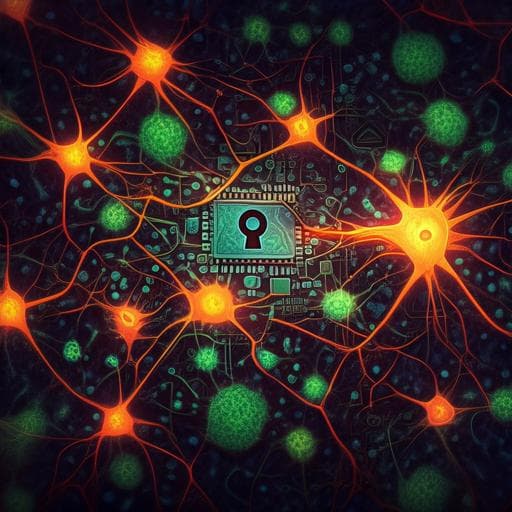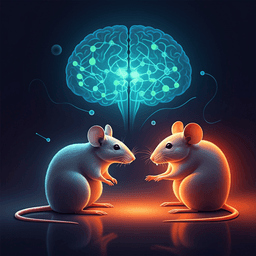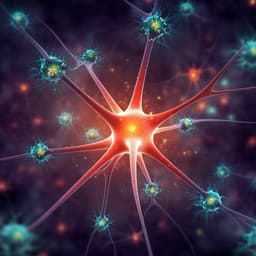
Medicine and Health
Single-nucleus genomics in outbred rats with divergent cocaine addiction-like behaviors reveals changes in amygdala GABAergic inhibition
J. L. Zhou, G. D. Guglielmo, et al.
Explore groundbreaking research by Jessica L. Zhou and colleagues uncovering cell-type-specific gene regulatory programs in the amygdala associated with cocaine addiction. Their experimental findings reveal how genetic factors and chromatin accessibility influence addiction behaviors, providing insights that could pave the way for innovative treatments.
~3 min • Beginner • English
Introduction
Addiction engages the amygdala to form drug-associated memories and mediate negative emotional states during withdrawal, yet the roles of distinct amygdalar cell populations and their gene regulatory programs in addiction remain unclear. Prior single-nucleus studies characterized brain cellular diversity and drug-induced changes but were largely performed in inbred strains and focused on acute, experimenter-administered drug exposure, limiting insights into genetic susceptibility and long-lasting adaptations. This study investigates, after prolonged abstinence, how cell-type-specific gene expression and chromatin accessibility in the amygdala of genetically diverse, outbred rats relate to divergent cocaine addiction-like behaviors. The research aims to identify molecular pathways—particularly those linked to cellular energetics and GABAergic signaling—and transcriptional regulatory mechanisms that differentiate high versus low vulnerability to cocaine addiction-like phenotypes.
Literature Review
The amygdala is crucial for emotions, motivation, memory, and is implicated in addiction, with established subregional roles of the basolateral (BLA) and central amygdala (CeA). Single-nucleus RNA-seq and ATAC-seq have mapped brain cellular diversity across species, and snRNA-seq has profiled reward circuitry and acute responses to cocaine and morphine in rodents. However, previous work used inbred strains and acute treatments, limiting evaluation of genetically mediated susceptibility and persistent neuroadaptations relevant to addiction. Transcription factor families such as AP1 and MEF2 have been implicated in addiction and show expression changes with chronic drug exposure. The study builds on these findings by using outbred, heterogeneous stock rats and extended-access cocaine self-administration (IVSA) to model escalation, motivation, and compulsive-like drug taking, enabling analysis of enduring molecular differences aligned with addiction-like behaviors.
Methodology
Animals and behavioral model: Outbred heterogeneous stock (HS) rats underwent extended-access intravenous self-administration (IVSA) of cocaine: 10 short-access (ShA, 2 h/day) sessions followed by 14 long-access (LgA, 6 h/day) sessions at 0.5 mg/kg per infusion. Motivation was assessed using a progressive ratio (PR) schedule after ShA and LgA; compulsive-like responding was measured by pairing 30% of lever presses with footshock. An addiction index (AI) was computed per rat as the mean of z-scored escalation, motivation, and footshock measures; rats were split into high and low AI groups.
Single-nucleus profiling: After 4 weeks of abstinence, amygdala tissues (including BLA and CeA) were dissected. snRNA-seq was performed on 19 rats (6 high AI, 6 low AI, 7 naive), and snATAC-seq on 12 rats (4 high AI, 4 low AI, 4 naive). In total, 163,003 snRNA-seq nuclei and 81,912 snATAC-seq nuclei passed QC. Clustering and annotation used known markers to define main cell types (excitatory and inhibitory neurons, astrocytes, microglia, oligodendrocytes, OPCs, endothelial) and neuronal subtypes (seven inhibitory subtypes; 18 excitatory clusters). CeA and BLA snRNA-seq data from a founder strain related cellular identities to subregions.
Gene expression analyses: Differential expression between high and low AI within each cell type used a two-sided negative binomial test (Seurat), with permutations to assess calibration. DEGs were partitioned by effect size, and enrichment for independent brain eQTLs was tested. A genetic prediction framework trained on whole-brain bulk RNA-seq (n=339 naive HS rats) was used to model cis-genetic contribution to expression; predicted high vs low AI differences were compared to observed cell-type-specific DEGs.
Pathway analyses: Gene set enrichment analysis (GSEA) of KEGG pathways was performed on ranked differential expression statistics per cell type.
Electrophysiology: In a separate cohort (5 naive, 5 low AI, 5 high AI), CeA slices were prepared after 4 weeks abstinence. Spontaneous inhibitory postsynaptic currents (sIPSCs) were recorded at baseline and following acute bath application of the glyoxalase 1 (GLO1) inhibitor pBBG (2.5 µM). Frequency and amplitude were quantified; group comparisons used ANOVA and paired t-tests.
Behavioral pharmacology: In a separate cohort (n=26), cue-induced reinstatement of cocaine seeking after abstinence was tested following intraperitoneal pBBG (15 mg/kg) or vehicle in a Latin square design.
Chromatin accessibility and TF activity: snATAC-seq peaks were called (MACS2), merged, and cell-type-specific differential accessibility between high and low AI was tested with negative binomial models, with permutations for calibration. Promoter enrichment for DA peaks and overlap with DEGs were assessed via Fisher’s exact tests. TF motif activity differences were quantified using chromVAR; motifs were clustered (e.g., bHLH, FOX, SOX, AP1/MEF2) and deviation scores compared between groups per cell type.
Cross-species relevance: Accessible peaks were lifted over to hg19, and cell-type-specific partitioned heritability enrichment was tested by LD score regression using GWAS summary statistics for tobacco and alcohol use traits.
Quality control and integration: Standard QC metrics (mitochondrial reads, TSS enrichment, nucleosome signal, fragments in peaks) and integration (Seurat, Harmony; UMAP visualization) were applied. Statistical significance thresholds primarily used FDR < 10%.
Key Findings
- Behavioral divergence: High AI rats escalated cocaine intake during LgA while low AI did not (time × group interaction F13,572 = 4.175, P < 0.0001). Both groups earned fewer rewards in ShA vs LgA (interaction P < 0.0001; F23,1012 = 8.523). Motivation increased in high AI from ShA to LgA (mixed effects, AI × phase P = 0.0049; Bonferroni P = 0.0001), but not in low AI. High AI rats persisted in drug-taking under footshock (unpaired t-test t44 = 3.936, P = 0.0003).
- Transcriptomic differences: Across cell types, 557 unique DEGs with large effects (|log2FC| ≥ 0.1) and 8,775 with small effects were identified (FDR < 10%). DEGs were enriched for brain eQTLs, supporting a genetic contribution. Notable DEGs included Kcnq3 (neuronal and glial), Fkbp5 and Sgk1 (glia), implicated in addiction-related processes. GSEA revealed enrichment of pathways related to neurotransmission and energy metabolism, especially oxidative phosphorylation and glycolysis/gluconeogenesis.
- Genetic prediction concordance: Predicted expression differences from cis-genetic models (trained on 339 naive HS rats) significantly correlated with observed differences for microglia, oligodendrocytes and inhibitory neurons (Spearman ρ, P < 0.05), indicating a genetic component to expression differences.
- Electrophysiology: Baseline CeA sIPSC frequency increased progressively from naive to low AI to high AI (one-way ANOVA F2,12 = 6.77, P = 0.0051), with no amplitude changes. GLO1 inhibition with pBBG reduced sIPSC frequency in low AI (t = 5.07, P = 3.9 × 10⁻3) and high AI (t = 11.83, P = 7.6 × 10⁻5) but not in naive rats (t = 0.71, P = 0.51).
- Behavioral pharmacology: pBBG reduced cue-induced reinstatement in high AI rats (Bonferroni-adjusted P = 0.024) but not in low AI rats; AI × treatment interaction F1,24 = 6.609, P < 0.05.
- Chromatin accessibility: >20,000 peaks showed significant differential accessibility (FDR < 10%). Directional biases were pronounced: excitatory neurons had >8,000 upregulated peaks and only 2 downregulated in high AI; inhibitory neurons showed >4,000 downregulated and ~500 upregulated peaks in high AI. DA peaks were enriched at promoters/TSSs and overlaps with DEGs’ promoters (FET P < 0.05), including oxidative phosphorylation genes.
- Transcription factor motifs: Motif clusters for bHLH, FOX, SOX, RFX and AP1/MEF2 showed significant, cell-type-specific differences. bHLH-like motifs were markedly more accessible in excitatory neurons of high AI rats (deviance 3.8; P = 1 × 10⁻280) and modestly in inhibitory neurons (deviance 0.38; P = 1 × 10⁻34). AP1 TF gene expression (Fos, Fosl1, Jun family) was decreased in inhibitory neurons of high AI rats, consistent with reduced AP1 motif activity.
- Human relevance: Cell-type-specific accessible chromatin regions from rats showed significant heritability enrichments (FDR < 10%) for GWAS traits related to alcohol and tobacco use across multiple cell types (notably neurons, astrocytes, oligodendrocytes, OPCs).
Discussion
This study demonstrates that divergent cocaine addiction-like behaviors after prolonged abstinence are associated with widespread, cell-type-specific changes in gene expression and chromatin accessibility in the amygdala. High AI rats exhibit elevated GABAergic transmission in the CeA and increased relapse-like behavior, both of which are mitigated by inhibiting GLO1, linking cellular energy metabolism (glycolysis-derived methylglyoxal) to GABAAR-mediated inhibition and addiction-related behaviors. The enrichment of DEGs for oxidative phosphorylation and glycolysis pathways across multiple cell types suggests that altered cellular energetics contributes to neural circuit function relevant to addiction. Chromatin accessibility differences were highly directional and cell-type-specific—greater in excitatory neurons and reduced in inhibitory neurons of high AI rats—implicating differential activity of pioneer TFs (bHLH, SOX, FOX) and AP1/MEF2 in orchestrating broad regulatory programs. The overlap of DA promoter regions with DEGs underscores coherence between epigenomic and transcriptomic alterations. Correlations between predicted (cis-genetic) and observed expression differences support a genetic contribution to the molecular phenotypes, consistent with polygenic models of complex traits, while cocaine exposure likely also contributes. Cross-species heritability enrichments indicate translational relevance to human addiction traits.
Conclusion
The work provides a single-nucleus atlas of gene expression and chromatin accessibility in the rat amygdala under conditions modeling vulnerability and resilience to cocaine addiction-like behaviors. It identifies altered cellular energetics and GABAergic signaling—mediated in part through the glycolysis byproduct methylglyoxal and its metabolism by GLO1—as key features of high addiction-like phenotypes. Pharmacological inhibition of GLO1 normalizes CeA GABAergic transmission and reduces relapse-like behavior in high AI rats, highlighting GLO1 as a potential therapeutic target. Epigenomic analyses implicate pioneer transcription factors and AP1/MEF2 in extensive, cell-type-specific chromatin remodeling associated with addiction-like states. Future research should dissect causal roles of specific metabolic enzymes and TFs using cell-type- and region-specific manipulations, expand genetic analyses (e.g., polygenic risk, larger cohorts), and map the functional consequences of regulatory changes across amygdalar circuits.
Limitations
Disentangling genetic predisposition from cocaine exposure effects remains challenging; while predicted-vs-observed expression correlations support a genetic component, the predictive models were trained on whole-brain bulk tissue (lacking cell-type resolution), have modest cohort size (n=339), and capture only cis effects. Most molecular differences are small in effect and distributed across many loci and peaks, complicating mechanistic attribution. Pharmacological GLO1 inhibition is not cell-type- or region-specific, limiting inference about specific neuronal or glial contributors. Electrophysiological changes in sIPSC amplitude were not detected, leaving uncertainty about postsynaptic effects. The study focuses on male rats for single-nucleus datasets, and broader sex-specific analyses were not performed. Finally, causal links from specific TFs or metabolic pathways to behavior require direct, cell-type-specific perturbations.
Related Publications
Explore these studies to deepen your understanding of the subject.







